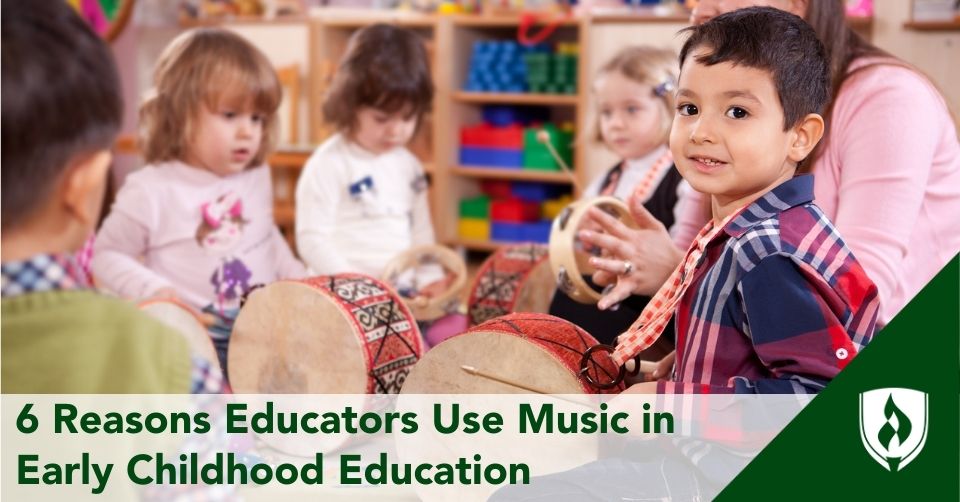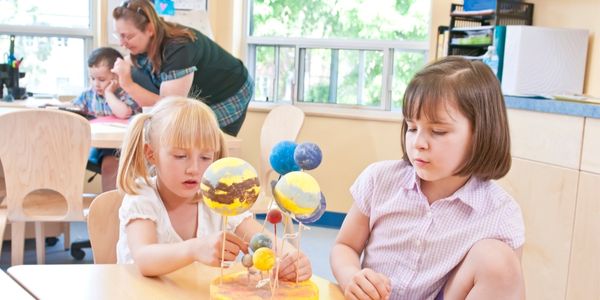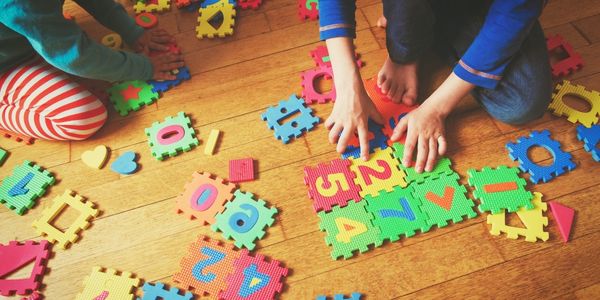
It’s another morning, and students are arriving. Some race around the classroom, and some look a little nervous about all the excitement until the teacher gathers everyone for “circle time." Today, like every day, the teacher leads the students in a welcome song, and everyone claps as they sing the memorized tune.
This scene might sound familiar to anyone who works with younger kids, but have you ever wondered why?
Music can enhance child development in ways any parent or teacher will get excited about. Here's why music is such a big deal in early childhood education, along with a few ways to incorporate it into your classroom.
Why do little kids love music?
Children love music so much because it truly lights up their minds, according to Andrea Gaitan, a board-certified music therapist with Toneworks Music Therapy.
“Music engages the whole brain,” Gaitan says. “Most school activities tend to rely on specific areas in the brain, but music crosses those borders.” Gaitan has visited classrooms as an early childhood music education specialist, offering special music times.
“The value of music in education has been recognized for centuries,” adds Carmine Visone, owner of Home Away From Home Academy. He says early interaction with music is important to early childhood development and can positively affect the quality of their life.
How music benefits young children
Early childhood educators often use music as a classroom management tool, helping children get on board for transition times (such as washing up before a snack or singing a goodbye song). Music can grab their attention and keep it, which is no small feat when you work with children from infancy to four or five years of age.
But the benefits of music in early childhood education go far beyond that.
1. Music aids memorization
Can you recall the theme song from your favorite childhood TV program? What about the lullabies your parents used to sing to you at night? Anyone who’s ever had a song stuck in their head has had a lesson in how hard it is to forget words set to music.
Visone says that's the reason we learn to sing our ABCs. Toddlers usually aren’t reading fluently, but they have a real knack for memorizing songs. Teaching kids those simple songs serve as fabulous tools for early literacy training and help the brain recall memorized information long term.
Even very young children, like infants, benefit from hearing the sounds and tones in music. It's good for early language development.
2. Music education develops fine motor skills
The development of fine motor skills is an increasing concern in this age of phones, tablets and flat-screen-interaction. Children need to practice and develop the fine motor skills that will allow them to manipulate small objects, use a scissors, etc... Music can be a great way to do that.
“When I bring an instrument into a classroom, every eye is on me,” Gaitan says.
Instruments can be beautiful and strange-looking, so children tend to want to hold and touch them. When this desire is encouraged, kids get the chance to hone their fine motor skills.
Gaitan points out that playing an instrument often requires movement children don’t practice very often in their daily routines. Visone adds that playing an instrument does wonders for hand-eye coordination.
3. Music education develops language and reasoning centers
“Early music education will develop the areas of the brain related to language and reasoning,” Visone says. He goes on to explain that the left side of the brain is better developed with music, and songs can help imprint information on young minds.
Language center stimulation in a toddler’s actively growing brain gets an extra boost of attention and breadth when music is involved.
Teaching music even as your learners grow into school age children can continue to have great benefits for their cognitive development. Music education has shown to positively benefit verbal memory, literacy and even second language pronunciation accuracy.
4. Music helps children cope and feel calm
Music is a useful tool in therapy. And in early childhood education, when students are sometimes too young to explain their feelings or desires, the therapeutic effects of music can help add a dimension of emotional processing, safety or calm to their day.
“You never know the whole story of children in a preschool class or daycare,” Gaitan explains. “There may be undiagnosed behavioral or anxiety issues. Music can get past those barriers. It involves and unifies everyone.”
Music therapy has had excellent results in developing speech, motor, social and cognitive functions in children with cerebral palsy, autism spectrum disorder and anxiety disorders. And if you've ever reached for a certain playlist, soundtrack or song when you are feeling down or needing to focus, you can understand how beneficial music is when it comes to emotional regulation.
5. Familiarity with music boosts confidence
Learning to play a piece of music or sing all the words to a song correctly will challenge a child. Once they have mastered that challenge, the child will typically feel proud of their achievement.
Children learning music can also be more emotionally developed and capable of empathy towards others. They also tend to be better at handling anxiety and have higher self-esteem.
Children who learn to play an instrument will have to set time aside to practice. Rising to the challenge of mastering that instrument can be a valuable lesson in discipline.
And children in an ECE classroom who learn to sing a song together (call and response songs are a great example) will feel a sense of community, belonging and routine when they all sing together.
6. Music education helps kids get excited about learning
Music is one of the greater pleasures in life for many people, and there’s a reason for that. Little lights go on all across different regions of the brain when we listen to music—even music we don’t like. Learning music, additionally, is credited as an extremely beneficial practice for lifelong brain health.
Basically, our brains appreciate music.
“Introducing music in the early childhood years can help develop a positive attitude toward learning and curiosity,” Visone says. “Music is enjoyable as well as educational, and it keeps children interested and engaged in school.”
Music activities you can use with young learners
This all sounds pretty great, right? So what can the average educator, parent or childcare provider do to introduce some of these music therapy techniques (and their benefits) to kids?
Here are a few ideas.
Instrument show and tell
If you play an instrument, do it in front of your kids. Or have a friend or a music therapist bring one in for a special show.
“Recorded music isn’t the same thing,” Gaitan says. “Playing an instrument live is more experiential for the kids. They see where the music comes from and want to hold the instrument. It’s multi-modal learning.”
Dance to music
If you ever play music with your children, there’s probably some dancing going on already. Encourage this activity and structure it into your day.
“I know so many teachers who start every morning with songs to get kids to move their bodies,” Gaitan says. “It gets everyone on the same page if they are all clapping together.”
You could also use music and dancing spontaneously whenever kids need to get focused. Children can get their fidgets out, while mentally zooming in. “Music helps focus the whole class,” Gaitan adds.
Make visual schedules and use songs to support them
“Kids love predictability,” Gaitan says.
Gaitan often works with children who have special learning needs and she emphasizes that a strong, familiar schedule is vital to help kids feel safe. When students have a hard time transitioning from one activity to another, or even transitioning to go home with mom and dad, she recommends making a song to give them the cue.
“We make songs to help them walk through the door or clean up after an activity,” Gaitan shares. “Establishing a routine with music helps the kids remember and feel secure about what’s coming next.”
Make something memorable
“There’s a lot of talking in classrooms,” Gaitan says. “Kids get burned out just listening.” But music is a different story. Music can liven up any lesson.
“We all know you can learn with songs. The recall memory goes way back,” Gaitan says. She recommends translating important information into music. “Putting music to a lesson on manners, or the classroom rules song helps everyone remember and engage.”
Not just knowing, but knowing why something works
The benefits of music are so exciting, and it is well worth bringing into the ECE environment. You might even be tempted to take up an instrument yourself. Kids naturally burst into song and pick up on melodies, and when you encourage these tendencies, you make yourself an ally with their natural growth.
Parents and teachers have been using music and rhymes as far back as we have recorded history. Knowing why music is such a powerful tool to a developing brain is a great example of what educators learn in early childhood education (ECE) degree programs. Many good things we are used to doing with children are based in tradition, but are also supported by research.
But sometimes that isn't the case. There are plenty of things parents and teachers have done for centuries that counteract growth or are not in line with what we know about how children develop.
Check out 6 Common ECE Myths (And The Early Childhood Education Facts) to see some examples.
The Early Childhood Education programs at Rasmussen University are not designed to meet, and do not meet, the educational requirements for licensure to teach in public preschools, or kindergarten, elementary or secondary schools in any state. The Rasmussen University Early Childhood Education programs are not approved by any state agency that licenses teachers. Before enrolling, it is important to understand all of the licensure eligibility standards for a desired career by consulting the appropriate state and school/facility requirements.




